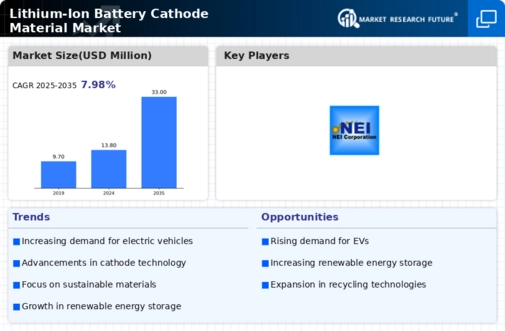Market Analysis
In-depth Analysis of Lithium Ion Battery Cathode Material Market Industry Landscape
The Lithium-Ion Battery Cathode Material Market features an array of compelling trends by which it is propelled forward and changed. With demand for electric cars taking off in part due to environmental considerations and government incentives, the lithium-ion battery cathode material industry is booming. The key to improving the performance and energy density of EV batteries is optimizing their cathode materials, including lithium cobalt oxide (LiCoO2), lithium manganese oxide (LiMn2O4) and lithium iron phosphate (LiFePO4). At present research and development is being pursued to increase the efficiency and stability of cathode materials. Advances in nanotechnology and material engineering look forward to higher conductivity, longer life for lithium-ion batteries. Such advanced cathode materials as those with higher energy densities, faster charging capabilities and longer cycle life are necessary for battery technology to move forward. The proliferation of smartphones, notebooks and so forth boost demand for lithium-ion batteries. This in turn increases the need for cathode materials. High-performance cathode materials are required to maintain the trend in consumer electronics toward ever smaller, lighter and more powerful devices. Raw materials are crucial in the lithium-ion cathode material battery market. Lithium, nickel, manganese and cobalt can all be used here. The stability of the supply chain is influenced by issues related to geopolitics, mining laws and commodity price fluctuations--and these in turn affect market dynamics and pricing. Environmental and ethical worries about cobalt mining have driven a move toward cobalt-free or low-cobalt materials for the electrode/coated electrodes composing the battery. To minimize reliance upon rare or difficult to obtain raw materials, manufacturers are experimenting with formulations like lithium iron phosphate (LFP) and nickel-manganese-cobalt (NMC). Electric car subsidies and renewable energy projects by government affect lithium-ion batteries' demand for cathode materials. Therefore, through encouraging investment in battery technology and sustainable energy solutions along with a favorable regulatory environment supported by incentives of various kinds, market scale can be stimulated. Increasing reliance on solar and wind energy requires efficient means of storing electricity, creating more demand for lithium-ion batteries as well cathode materials. Replete with business potential, these energy storage systems are based on lithium-ion batteries and help to stabilize the grid. As for the lithium-ion battery cathode material industry, competitors compete furiously. This promotes innovation and strategic cooperation. In such a competitive and changing market, companies merge or acquire to increase their product lines; build up technology development capability, gain an advantage over competitors.




Leave a Comment